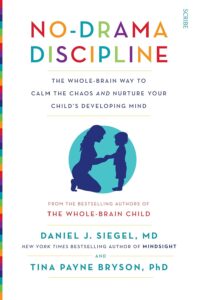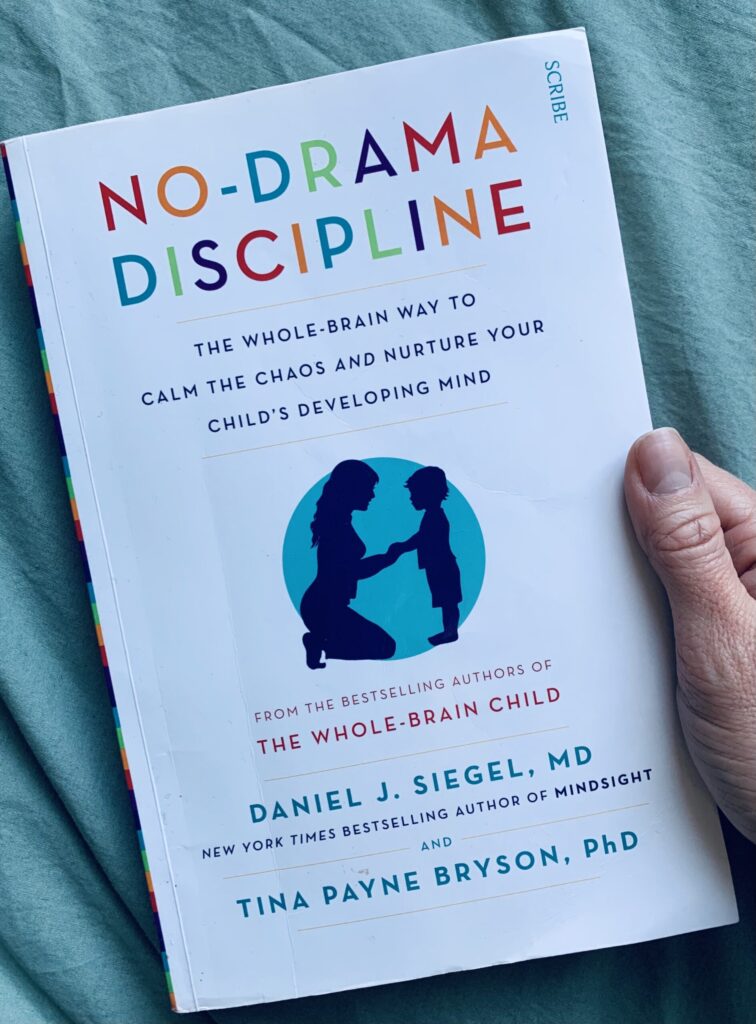 No-Drama Discipline
No-Drama Discipline
The Whole-Brain Way to Calm the Chaos and Nurture Your Child’s Developing Mind
Daniel Siegel and Tina Payne Bryson
Scribe UK; UK edition (15 Jan. 2015)
About Dan Siegel and Tina Payne Bryson
Daniel J. Siegel, M.D., received his medical degree from Harvard University and is currently a clinical professor of psychiatry at the UCLA School of Medicine and the founding co-director of the Mindful Awareness Research Center at UCLA. An educator, he is a Distinguished Fellow of the American Psychiatric Association and recipient of several honorary fellowships. The executive director of the Mindsight Institute, the medical director of the LifeSpan Learning Institute and on the advisory board of the Blue School in New York City, which has built its curriculum around Siegel’s Mindsight approach. His psychotherapy practice includes children, adolescents, adults, couples, and families.
Tina Payne Bryson, PhD, is the Founder and Executive Director of The Center for Connection, a keynote speaker and a mom of three boys. She conducts workshops for parents, educators, and clinicians worldwide, and she frequently consults with schools, businesses, and other organizations.
About The Book
“You really can discipline in a way that’s full of respect and nurturing, but that also maintains clear and consistent boundaries. In other words, you can do better. You can discipline in a way that’s high on relationship, high on respect, and low on drama and conflict-and in the process, you can foster development that builds good relationship skills and improves your children’s ability to make good decisions, think about others, and act in ways that prepare them for lifelong success and happiness.”
When it comes to parenting, Dan Siegel and Tina Payne Bryson are like trusty guides, helping millions of parents worldwide become better at it. Their book The Whole-Brain Child totally changed how I parent, leading me to dive into all their other books like The Yes Brain Child, The Power of Showing Up, and Dan’s main work, Mindsight. Recently, I grabbed their manual on effective discipline – No Drama Discipline – and it didn’t disappoint.
Rooted in the science and principles of The Whole-Brain Child, this book focuses on applying this wisdom when tensions rise, offering a compassionate roadmap for handling tantrums and challenging behaviours without creating unnecessary drama. The core message emphasizes that every tough moment is an opportunity to nurture crucial executive skills in our children, reframing discipline as a teaching opportunity rather than simply punishment. This approach isn’t just for parents—it’s a valuable tool for anyone working with children, and I’ve found it surprisingly effective even in interactions with adults.
One thing I love about Dan and Tina’s books is how they give simple frameworks that I can use right away. They stick in my mind like guiding stars on my parenting journey. And like all their parenting books, No Drama Discipline comes with a handy refrigerator sheet that summarizes all the strategies – check it out!
Without further ado, I can’t wait to share my favourite ideas from the book.
Key Insights:
Discipline is About Teaching
“The word “discipline“ comes directly from the Latin word disciplina, which was used as far back as the eleventh century to mean teaching, learning, and giving instruction. So, from its inception in the English language, “discipline“ has meant “to teach.”
Dan and Tina set the stage with the definition of the word “discipline.“ And it’s such a powerful insight – discipline means “to teach.”
Now, effective discipline has two main goals: getting our kids to cooperate at the moment (short-term) and helping them develop skills and the capacity to resiliently handle challenging situations, frustrations, and emotional storms that might make them lose control (long-term).
While many parents default to consequences like time-outs, taking away a privilege, or spanking, Dan and Tina argue that these tactics and any other punitive reactions are in fact counterproductive – they don’t only teach kids the skills and help their brains grow, but often even don’t achieve a short-term goal of getting a child to cooperate. They create loads of unnecessary drama and damage our relationship with a child.
Instead, they advocate for a no-drama discipline approach summed up as “connect and redirect.“ Just like in The Whole-Brain Child, they emphasize that every tough moment with our kids is a chance to help them grow and develop important skills for their future.
Intentional Discipline – Being Reactive vs Being Responsive
“Instead of being reactive, we want to be responsive to our kids. We want to be intentional and make conscious decisions based on principles we’ve thought about and agreed on beforehand. Being intentional means considering various options and then choosing the one that engages a thoughtful approach toward our intended outcomes.”
Now, Here’s the tough part: disciplining ourselves to be less reactive and more intentional.
To be responsive instead of reactive, we have to know what we actually want to accomplish when our child misbehaves. The authors give us a simple but powerful tool: the three questions: Why? What? How?
Before you react to misbehaviour, pause and ask yourself:
- Why did my child act this way? Get curious, don’t assume. Every action has a reason, so dig deep before reacting. Sometimes, it’s not that they won’t behave, but that they can’t right now. Understanding first helps us respond better and with more compassion.
- What lesson do I want to teach in this moment? Self-regulation, the importance of sharing, acting responsibly, or anything else.
- How can I best teach this lesson? Think about your child’s age and development stage, then choose the best way to get your point across.
It’s a great way to break out of autopilot and be more deliberate in our parenting. That’s what conscious parenting is all about.
In the book, the authors encourage us to reflect on our own discipline philosophy and share questions to guide our thinking. Seriously, grab the book for more – it’s like having a parenting coach on hand.
P.S.: If you’re curious about diving deeper into understanding children’s behaviour, check out our notes on Mona Delahooke’s fantastic book Beyond Behaviours.
Setting Limits Helps Children Build Their Brains
“When we set limits, we help develop the parts of the upstairs brain that allow children to control themselves and regulate their behaviors and their body.
One way to think about it is that we’re helping our kids develop the ability to shift between the different aspects of what’s called the autonomic nervous system. One part of the autonomic nervous system is the sympathetic branch, which you can think of as the “accelerator“ of the system. Like a gas pedal, it causes us to react with gusto to impulses and situations, as it primes the body for action. The other part is the parasympathetic branch, which serves as the “brakes“ of the system and allows us to stop and regulate ourselves and our impulses. Keeping the accelerator and the brakes in balance is key for emotional regulation, so when we help children develop the capacity to control themselves even when they’re upset, we’re helping them learn to balance these two branches of the autonomic nervous system.
Purely in terms of brain functioning, sometimes an activated accelerator (which might result in a child’s inappropriate and impulsive action) followed by the sudden application of brakes (in the form of parental limit setting) leads to a nervous system response that may cause the child to stop and feel a sense of shame. When this happens, the physiologic manifestation might result in avoiding eye contact, feeling a heaviness in her chest, and possibly experiencing a sinking feeling in her stomach. Parents might describe this by saying she “feels bad about what she’s done.”
This initial awareness of having crossed a line is extremely healthy, and it’s evidence of a child’s developing upstairs brain. Some scientists suggest that limit setting that creates a “healthy sense of shame“ leads to an internal compass to guide future behavior. It means she’s beginning to acquire a conscience, or an inner voice, along with an understanding of morality and self-control. Over time, as her parents repeatedly help her recognize the moments when she needs to put on the brakes, her behavior begins to change. It’s more than simply learning that a particular action is bad, or that her parents don’t like what she’s done, so shed better avoid that action or she’ll get in trouble. More occurs within this child than just learning the rules of good vs. bad or acceptable vs. unacceptable.”
Absolutely spot on. Kids thrive when we set clear boundaries and communicate our expectations.
It reminds me of Jordan Peterson’s insight in 12 Rules For Life. Rule number 5 says: don’t let your kids do things that make you dislike them. As parents, our main job is to help our kids become sociably acceptable by teaching them how to behave and control themselves – and that means discipline.
P.S.: That also made me think of Brene Brown’s mantra from Dare to Lead: “Clear is kind. Unclear is unkind.“ When it comes to discipline, setting clear boundaries is kindness in action. Being wishy-washy and inconsistent? Not so much.
Proactive Parenting
“At times we can avoid having to discipline at all, simply by parenting proactively, rather than reactively. When we parent proactively, we watch for times we can tell that misbehavior and/or a meltdown is in our children’s near future—it’s just over the horizon of where they are right now—and we step in and try to guide them around that potential landmine.”
Dan and Tina also urge us to be proactive. Often, we can dodge major tantrums and meltdowns if we catch things early. They suggest using the HALT framework: when our child’s behaviour is trending in a direction we don’t like, we should ask ourselves, “Is he hungry, angry, lonely, or tired?”
From my own experience, this approach has saved me from countless dramas.
Connection Comes First
The first step in effective discipline is to connect with your child. Why?
Well, first off, because connection moves a child from reactivity to receptivity. Tina and Dan explained it beautifully with a simple flow diagram:
Discipline is about teaching -> Teaching requires children to be receptive to learning -> Receptivity results from connection -> Connection moves kids from reactivity to receptivity
Secondly, connection builds the brain by improving a child’s capacity for relationships, self-control, empathy, personal insight and other executive skills. In short, it strengthens the link between the “upstairs“ and “downstairs“ parts of the brain.
Third, connection deepens the relationship with your child. Our bond strengthens not just during fun times like playing games or reading bedtime stories but also when we’re there for them in the tough moments. When we show them that we love them even when they’re falling apart and at their worst.
Here, the authors emphasize that the main goal of connection is to help kids feel felt and know that we are with them right in the middle of whatever they are going through.
So, now let’s move from theory to practice.
How to Connect With Kids
In the book, Dan and Tina highlight three principles of effective connection:
- Turn down the shark music: “Let go of the background noise caused by past experiences and future fears.“ In the book They use the metaphor of “shark music“ from the Circle of Security Intervention Program – you can watch the video here to grasp the concept better.
- Chase the Why: “Instead of focusing only on behaviour, look for what’s behind the actions: Why is my child acting this way? What is my child communicating?”. Be curious.
- Think about the how. It’s not just what we say to our kids but how we say it that matters. Our tone and how we frame our messages make a big difference. For example, “If you get in bed now, we’ll have time to read. But if you don’t get in bed right away, we’ll run out of time and have to skip reading.” Vs: “If you don’t get in bed now, I’m not going to read anything to you.”
To put all of this into practice, Dan and Tina share a powerful framework called The No-Drama Connection Cycle:
- Communicate Comfort. When we show signs of frustration or anger, it triggers a stress response in our kids’ brains. By regulating our own emotions first and signalling that we’re not a threat, we help calm their amygdala and encourage their thinking brain to kick in. Non-verbal cues like a hug or a nod and getting down to their eye level can work wonders to convey calmness.
- Validate, validate, validate. “Even when you don’t like the behaviour, acknowledge and even embrace feelings.“ We need to let our kids know that we hear them, we understand, we get them. That we want to attune to their inner subjective experience. Validation is about resisting the temptation to deny or minimize our kids’ big feelings.
- Stop talking and listen. “When your child’s emotions are exploding, don’t explain, lecture, or try to talk her out of her feelings. Just listen, looking for the meaning and emotions your child is communicating.“ This is what empathetic listening looks like in action.
- Reflect. “Once you’ve listened, reflect back what you’ve heard, letting your kids know you’ve heard them.“ And the cycle repeats.
This approach reminded me a lot of the empathetic listening technique from Marshal Rosenberg’s insightful book, Nonviolent Communication. You might find our notes helpful too.
P.S.: Dr Becky has exactly the same philosophy in her brilliant book Good Inside – check out our notes.
1-2-3 Discipline
Once we’ve calmed down and connected with our child, we can move on to the next step of effective discipline: redirection. To guide us through this step, Dan and Tina offer a simple 1-2-3 Discipline framework:
1 Definition:
Discipline is about teaching.
2 Principles:
– Wait Until Your Child Is Ready (and you are, too): when a child’s emotions are dysregulated, his upstairs brain is offline. Wait till your child calms down and is in a more receptive state.
– Be Consistent But Not Rigid. Kids need to know what to expect from you (consistency), but they also need to know that at times you will thoughtfully consider all the factors involved. It’s ok to make exceptions sometimes and consider what works best for the child at that particular moment.
3 Desired Outcomes:
Our ultimate goal is to help our child develop mindsight:
- Insight: helping children understand their feelings and how they respond to difficult situations.
- Empathy: helping children understand how their actions impact others.
- Repair of ruptures and integration: helping them find a way to make things right.
Now let’s move to the practical strategies you can use to address your child’s behaviour.
R-E-D-I-R-E-C-T Strategies
In the book, Dan and Tina offer eight strategies that we can use to discipline our kids effectively – R-E-D-I-R-E-C-T:
- Reduce words: Kids don’t need a long lecture about their mistakes. Be brief. Address the behaviour and feelings behind the behaviour and move on.
- Embrace Emotions: say no to behaviour, but yes to the feelings and experiences. Validate, validate, validate.
- Describe, don’t preach: When we describe what we see (e.g. “I see shoes at the front door“ instead of “Put your shoes away!”) and ask for help in understanding (e.g. “I know you felt ready for the test, so I’m surprized you got a D. Were you surprized as well?”, “Can you help me understand?“ vs “I can’t believe you got D on your test! You told me you studied!”), we allow our kids to pause and let their brain do its work. They can take an active role in their response.
- Involve your child in the discipline: Instead of delivering a monologue, involve your child in the discipline. Look at it as parent and child against a problem, not as parent against the child.
- Reframe a no into conditional yes: Offer alternatives or compromises, like “Yes of course you can have dessert after you finish your dinner.“
- Emphasize the positive: Highlight what your child is doing right, like praising them for sharing instead of focusing on when they don’t. The same goes for communicating what you want from your child instead of what you don’t want (e.g. “I like it when you talk in your normal voice. Can you say that again?“ instead of “Stop whining!”)
- Creatively approach the situation: That’s about putting Playful Parenting principles in action. Use humour, be silly and discipline through play.
- Teach mindsight tools: Check out The Whole-Brain Child book for more resources.
So, there you have it – eight strategies that’ll make your parenting journey a whole lot smoother. They’ve certainly made a big difference for me in disciplining my kids.
And yes, there’ll be times when you lose your cool and get caught up in your child’s tantrum. But that’s ok. No one’s perfect. We’re all just human. The key is to focus on nurturing your relationship with your kids and repairing things after any rough patches. Remember, you can always apologize for any overreactions. Even from those messy moments, your kids can learn and grow.
Action Steps For You
- Connect before you correct: Before addressing your child’s behaviour, take a moment to connect emotionally. Show empathy, validate their feelings, and make sure they feel understood. This helps them feel safe and opens them up to learning.
- Use “connect and redirect” instead of punishment: Instead of resorting to punishment like time-outs or taking away privileges, focus on connecting with your child first, then guiding them towards more appropriate behaviour. Offer clear explanations and alternatives, emphasizing teaching over punishment.
- Practice the HALT framework: When you notice your child’s behaviour heading in a negative direction, pause and consider if they might be Hungry, Angry, Lonely, or Tired (HALT). Addressing these underlying needs often prevents or defuses challenging situations before they escalate.
Quotes From The Book
-
“When your child is at his worst, that’s when he needs you the most.”
-
“The way we interact with our kids when they’re upset significantly affects how their brains develop, and therefore what kind of people they are, both today and in the years to come.”
-
“We cannot, nor would we want to, protect or rescue our kids from all adversity and negative experiences. These challenging experiences are an important part of growing up and developing resilience, along with acquiring internal skills needed to cope with stress and failure and to respond with flexibility. What we can do is help our children make sense of their experiences so that those challenges will more likely be encoded in the brain consciously as “learning experiences,” rather than unconscious associations or even traumas that limit them in the future.”
-
“Like so many aspects of parenting, response flexibility is fundamentally about parenting intentionally. Were talking about remaining mindful of meeting the needs of your child – this particular child — in this particular moment. When that goal is central in your mind, connection will necessarily follow.”
-
“Discipline is about teaching. If we forget this simple truth, we’ll go off course. If discipline becomes about punishment, for example, we can miss the opportunity to teach. By focusing on the consequences of misbehavior, we limit the opportunity for children to experience the physiological and emotional workings of their inner compass.”
-
“There’s no way we can avoid experiencing conflict with our kids. And there’s no way we’ll always be on top of our game in how we handle our-selves. We’ll be immature, reactive, and unkind at times. What’s most important is that we address our own misbehavior and repair the breach in the relationship as soon as possible, most likely by offering and asking for forgiveness. By repairing as soon as we can in a sincere and loving manner, we model for our children a crucial skill that will allow them to enjoy much more meaningful relationships as they grow up.”



